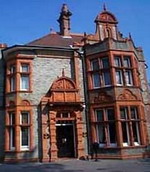In his map of "Wessex" appearing in his Wessex novels, the great 19th.century British novelist Thomas Hardy renamed Reading as "Auld Brickham":
East Redlands once had bricks kilns along with other parts of Reading (Katesgrove, Coley, Grovelands and Tilehurst), part of our rich heritage. Certain towns and cities across Britain have a distinctive flavour with regards to their building materials and architectural style. Bath for example is famous for its "Bath stone". But Reading I have termed "the brick city of Britain". Here bricks and and brick ornamentation left its creative mark on the landscape and flourished perhaps as nowhere in Britain. Wherever you go you will find bricks of many colours and also elaborate ornamental decoration in bricks. This is especially with regards to the shops of places like Broad Street in the town centre (only the upper floors of these magnificent frontages remain though).
The emergence of Reading as a university in its own right early in the twentieth century also saw a further expansion of the wealth of brick architecture. Particularly fine examples are: Wantage Hall; Foxhill House; The Library (at the old London road site); St.Andrews Hall (originally a house of the Palmer family and now the National Museum of English Rural life). Another fine example is what is now the Hillingdon Prince Hotel on Christchurch Road. And if you walk along Broad Street and glance above street level you will be astonished at the wealth of brick carving and detail.
Brickmaking was re-started in the 15th and 16th centuries. Typical Elizabethan bricks were smaller than modern ones, and initially expensive items, so were only used for important buildings, such as Hampton Court. Although in the Middle Sages there was immense rivalry between the Brickmakers Guild and the older Stonemasons Guild who resented the intrusion into their domain of the new craft, which in some market towns resulted in death. Simpler houses were timber framed, with wattle and daub infill, or if - say - a wealthy farmer, with some brick infill. These bricks would usually be made on an individual basis, for a specific building, and this practice continued until the 19th century - the remains of a kiln exist, for example, at Tadley made for the building of just 2 or 3 cottages.
The bricks used for the construction of Kendrick's workhouse The Oracle were made in Tilehurst (now west Reading) in 1627. One hundred years later by the time of George I (1714-1727) and II (1727-1760) the industry of brick-making and tileworks were well established in both Tilehurst and Katesgrove (just to the west of Redlands). However, by the late 19th. century most of the kilns in Katesgrove had become worked out worked out, except for the Waterloo Kilns and Rose Kilns (both names surviving in roads names thereabouts). At Coley (up on the ridge on the western edge of the old town), two firms were still making bricks in the late nineteenth century, but in 1885 one of these moved to Tilehurst. Samuel Wheeler founded Tilehurst Potteries at Kentwood Hill in 1885, and made roofing tiles and flower pots. S and E Collier, moved from Coley to Grovelends in lower Tilehurst. Here they continued until 1965.
With regards to Redlands, there were brick kilns in the area which is bounded by Bulmershe Roads to the west, Wokingham Road to the east, Crescent Road to the north and Whiteknights Road to the south. Maps of 1883 and 1885 still show the site of these.
Reading bricks have a distinctive red colour, although by different firing a yellow variety can be obtained, whilst by adding chalk, a white brick results. The blue-grey brick is also very distinctive. Many houses in the Reading area made use of these to create decorative patterns in their brickwork. This is especially so around the University area of Reading. The clays used would also make red or yellow bricks, and blue-grey brick. The works in the Bracknell and Wokingham area exported most of their production (particularly the yellow) to London - some yards having railway connections for the purpose.
A stroll around the Redlands area will reveal a wealth of brick heritage on almost every house: patterns, colours, textures, specially made and decorated and carved brick lintels, pilasters, arches, chimneys and so on.
Until the second half of the twentieth century, virtually every building in Reading was made of brick. There was then the intrusion of ill designed concrete ugliness. Recently however, there has been a high quality revival of brickwork in specialist designed detached houses around Reading (Redlands especially), creating a modern revival in a modern idiom for the Reading brick ambience. Commercial and governmental buildings too seemed to have rediscovered the heritage of the Reading brick.
(all text above: © Stephen B. Cox)
